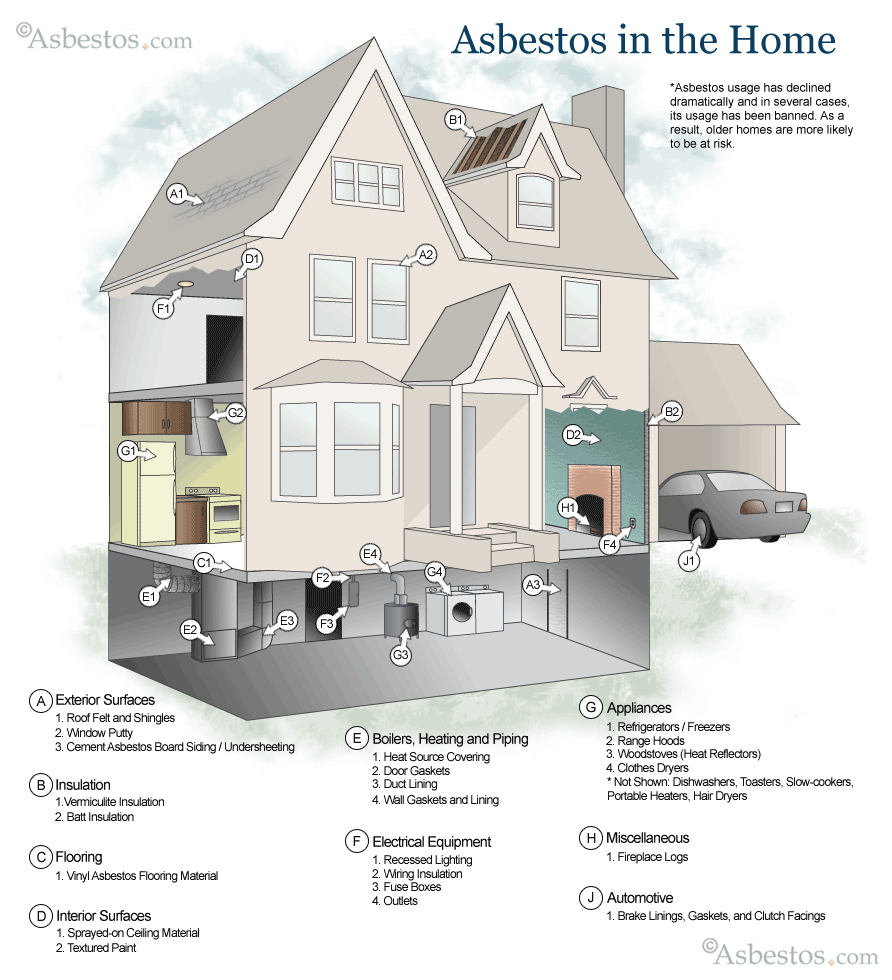Preventing Asbestos Exposure and Green Insulation Alternatives for Homebuyers - An Informational Article About Asbestos Exposure
 Utilized around the world for almost a century, asbestos is a fibrous mineral that was implemented for various building and construction applications. Commonly found as insulation for pipes, boilers, roofs, siding and flooring, it’s flame resistant and highly durable qualities once made it an ideal choice for manufacturers, who buried evidence of its toxic qualities from the public. This wrongfully exposed an entire generation to asbestos.
Utilized around the world for almost a century, asbestos is a fibrous mineral that was implemented for various building and construction applications. Commonly found as insulation for pipes, boilers, roofs, siding and flooring, it’s flame resistant and highly durable qualities once made it an ideal choice for manufacturers, who buried evidence of its toxic qualities from the public. This wrongfully exposed an entire generation to asbestos.Even today, many homes or buildings built prior to 1980 may still contain asbestos. This should not make home buyers overly worried because asbestos exposure can be easily prevented by taking simple precautions.
Regarded as one of the great American traditions, the road to purchasing a home is an important step in one’s life. Your home is your sanctuary, security and your investment. Although an exciting time for you and your family, it can also bring additional responsibilities into your life. Having the assistance of honest and reliable U.S./Canada real estate agents can make this process simple, happy and most importantly, stress free! The green movement has allowed for man insulation alternatives which provide healthy, sustainable and more Eco-friendly methods of insulation.
Healthy Tips
One of the main things that can go unnoticed when purchasing a home is taking simple precautions to avoid asbestos exposure. Many older homes may need remodeling or additional repairs. If any obsolete building materials are present, this can pose several dilemmas for homeowners.
If you locate any suspected asbestos in the home, most experts suggest leaving it un-disturbed until a home inspector can examine your property, take evaluations and determine the safest course of action. Sometimes the best action is no action at all. Disturbing asbestos in good condition may cause its fibers to be released into the air.
Exposure to damaged airborne asbestos fibers can lead to the development of a severe lung ailment known as mesothelioma. Many symptoms of mesothelioma mimic those of less serious conditions, which pose several problems for medical doctors. Asbestos-related illnesses may not appear until 20 to 50 years after exposure, which makes mesothelioma diagnosis even more difficult.
Removal of asbestos in public facilities, workplaces and homes should be performed by licensed abatement contractors as long as the National Emissions Standards for Hazardous Air Pollutants (NESHAP) are not violated. Not only are they trained in handling toxic materials, but come equipped with the proper safety gear required for such procedures.
Going Green in the Home
Throughout much of Canada and the United States, construction practices are upgrading methods to suit better lighting, heating, cooling systems and environmentally habitable insulation. On February 17, 2009, the United States congress passed the American Recovery and Reinvestment Act into law. Included in this act were extensions of the Energy Efficiency Tax Incentives first enacted in 2005 as well as some new tax credits for people building or remodeling their homes using Eco-friendly or “green” materials.
Some of the measures that are eligible for tax credits include added insulation to walls, ceilings, or other part of the building envelope that meets the 2009 IECC specifications, sealing cracks in the building shell and ducts to reduce heat loss. Storm doors paired with U-factored rated wood doors are also eligible.
If asbestos is removed, green forms of insulation should be used as replacements. Some Eco-friendly alternatives to asbestos insulation include: cellulose, which is becoming a popular new green insulation material. It is chemically treated to reduce levels of mold. Cotton fiber is made from recycled batted material and is then treated to be fireproof. These alternatives not only allow for a healthy and safe home, but studies have demonstrated that they can reduce annual energy costs by 25 percent annually.
Implementing green methods of building can have many other positive environmental, health and economic benefits. These include: increase in property value, conservation of natural resources, enhancement of air quality, energy sustainability, improve quality of life, improvement of pulmonary and cardiac health and reduction of waste.
Labels: American Recovery and Reinvestment Act, Asbestos Causing Cancer, Asbestos Exposure, Energy Efficiency Tax Incentive, Mesothelioma Cancer from Asbestos, Property Inspector







0 Comments:
Post a Comment
<< Home